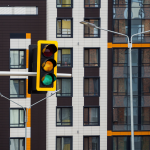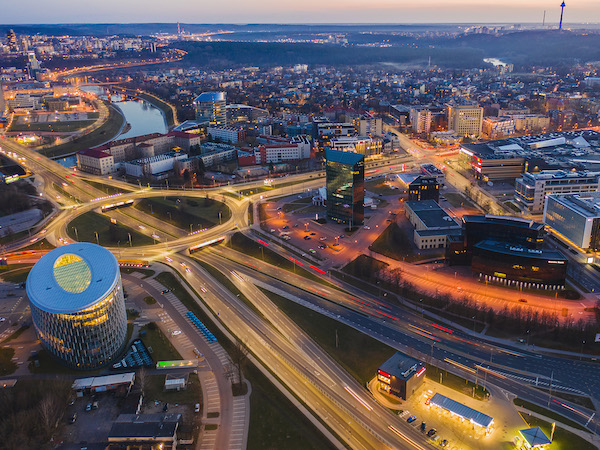Ober-Haus Celebrates 25 Years: How Has the Property Market Changed in a Quarter of a Century?
 In 1998, the Lithuanian real estate market was characterised by a lack of housing, poor credit conditions and an underdeveloped commercial real estate sector. Over the last 25 years, the number of apartments for sale has increased more than 10-fold, housing market activity has almost quadrupled, lending rates have fallen from double to single digits, and modern office buildings and shopping malls are now numbering in the hundreds – that’s the picture according to the Ober-Haus Real Estate Market Review 1998–2023, conducted to celebrate the company’s 25th anniversary.
In 1998, the Lithuanian real estate market was characterised by a lack of housing, poor credit conditions and an underdeveloped commercial real estate sector. Over the last 25 years, the number of apartments for sale has increased more than 10-fold, housing market activity has almost quadrupled, lending rates have fallen from double to single digits, and modern office buildings and shopping malls are now numbering in the hundreds – that’s the picture according to the Ober-Haus Real Estate Market Review 1998–2023, conducted to celebrate the company’s 25th anniversary.
The Year 2000 Marked the Beginning of the Creation of the Lithuanian Real Estate Market
The years 1998–2000 can be considered as the period when the real estate sector in Lithuania began to evolve. Due to the absence of credit services, the Lithuanian population was mostly only able to purchase a home using their own funds, and commercial construction with the intention to sell or lease was in its infancy. And so, 25 years ago, investors were developing single apartment blocks, business/office assets and shopping centres, where any new development for sale or rent was regarded as a significant event in the real estate market.
The Russian economic crisis, which began in 1998, had lasting negative consequences for the Lithuanian economy and prevented the real estate sector from developing more rapidly for at least a few years. Despite this, new-build housing gradually became available to a much wider segment of the population. Housing prices fell and the credit market started to grow much faster.
In Vilnius from 1998 to 2000, developers built around 300-500 flats for sale in apartment blocks each year, and from 2003 a major construction boom started in the capital (in Kaunas and Klaipėda it occurred from 2005, and in Šiauliai and Panevėžys from 2006–2007). It lasted until the height of the global financial crisis. After that, the real estate market and the construction sector were in recession for almost five years (2009–2013), followed by another period of active development. In recent years, developers in the capital have been building 10 times more apartments – around 4,000-5,000 – each year.
Improving affordability rates
Over the last 25 years, the statistical ratio of apartment prices to wages has been steadily changing, but the most influential factor was the surge in the housing credit market in 2002 and 2003, after which rapidly rising housing prices were offset by much improved financing conditions.
Although the price-to-wage ratio started to deteriorate rapidly in the period from 2004 to 2006, at the time, buyers were not concerned with the price of property, but rather with the possibility of financing 100% of the purchase for a very long period. This affordability ratio recovered only after the global financial crisis.
The rapidly growing credit market has led to the rapid development of the property sector
Twenty-five years ago, access to home mortgage loans was significantly worse than today: high equity requirements, short loan periods and annual interest rates of 10-15% or even higher. Up until the 2000s, only a few banks in Lithuania offered long-term housing loans, with a maximum loan term of 10 years.
The country’s economic recovery after the Russian crisis and the improving financial situation of individuals, and companies, attracted the attention of foreign investors and the credit sector. Seeing the growth potential of the undeveloped market, new lending institutions were actively setting up in Lithuania, and competing for customers on increasingly attractive lending terms: equity requirements and interest rates were falling and the maximum duration of loans was increasing significantly.
The breakthrough in the lending market came in 2002–2003, when banks first began granting housing loans for a period of 40 years (before that, the maximum loan period was 25 years). This clearly improved the affordability of homeownership, as the longer loan period allowed homebuyers to significantly reduce their monthly mortgage payments.
Since the late 1990s, the number of dwellings (apartments and private houses) purchased in Lithuania has been growing steadily and rapidly, with a relative peak in activity in 2005. In that year, almost 17 dwellings per 1,000 inhabitants were purchased, which was almost three times more than in 2000.
In the period 2007–2009, this indicator fell by almost 60% and relative market activity returned to the level of 2000–2001. Since 2009, it has taken 10 years to reach a new national record for housing market activity. The ensuing aftershock of another real estate boom, pushed housing prices and market activity to unprecedented heights. In 2021, there were already 20 dwellings purchased per 1,000 inhabitants in Lithuania.
The cost of credit expansion and the collapse of the property market
As subsequent events have shown, these radical changes in the credit market came at a price, paid for by the entire national economy and the real estate market at the height of the global financial crisis (2008–2009). It was the availability of housing credit to a large section of the population that opened up access to home ownership, producing unsustainable growth in the real estate market between 2004 and 2007.
Despite the attempts of housing developers to bring more and more new homes to the market each year, the market potential was noticeably higher and the real estate market was locked in a frenzy of price increases. According to Ober-Haus, sales prices of apartments in the country’s major cities increased by a factor of three between 2004 and 2007, while the affordability index dropped to record lows.
For example, in 2003, an average Vilnius resident could buy 5.1 sqm in a middle-class apartment in Vilnius based on their average net annual salary, whereas in 2007 this indicator was only 3.1 sqm. By 1998, the indicator in Vilnius was 5.5 sqm, rising in 2022 to 6.6 sqm.
Growth in the commercial property market
The rapidly improving availability of finance has given a huge boost to the country’s entire construction sector. It was only 20-25 years ago that residential and commercial projects started to develop more actively in the country’s major cities, allowing residents to settle in individual architectural designs and businesses to operate in modern, renovated or newly-built facilities. Offices became one of the fastest growing real estate segments in the country’s major cities, as start-ups and expanding companies sought to offer modern workplaces for their employees.
Over the last 25 years, more than 350 projects (including different development phases) have been completed in Vilnius, Kaunas and Klaipėda alone, providing over 1.4 million sqm of modern office space and currently employing around 150,000 employees.
The active development of shopping centres
The development of the retail sector has been no less impressive. In the late 1990s, the major grocery chains started to accelerate the opening of new supermarkets. The first retail and wholesale DIY centres for building materials, and the first traditional supermarkets opened their doors, offering a wide range of goods and services under one roof.
Currently, there are close to 60 larger shopping centres in Lithuania, with a total retail space of about 1.2 million sqm. Whereas in 2003 there was only 0.06 sqm of retail space per capita in such centres, by 2023 this indicator is seven times higher (about 0.41 sqm). This figure does not even include the large number of grocery stores currently operating across Lithuania or the larger-scale retail parks that are emerging.
Between 2000 and 2010, the total usable area in business centres and traditional shopping centres in Vilnius, Kaunas and Klaipėda grew 16-fold to almost 1.3 million sqm. Although the following decade (2010–2020) was characterised by a more moderate rate of growth in modern space (60% increase in total area), developers began to focus more on the qualitative aspects of development and to offer the market an increasing number of more innovative and diversified projects. The next decade is likely to be characterised by even greater qualitative diversity and a proliferation of refurbishment projects for buildings that are no longer fit-for-purpose or obsolete.
Quality property development
Looking at the changes in the country’s real estate sector over the last 25 years, one can clearly see not only a quantitative but also a qualitative leap in developments. Whereas a few decades ago the market was very receptive to any new project, nowadays it is much more interested in new development principles or products that are being used internationally. These include, energy efficiency, sustainability assessment standards for buildings, the application of ESG criteria, e-commerce, the ‘15-minute city’ concept, co-living and working spaces, temporary shops and the development of multifunctional business space projects.
Latest news
 All news
All news

“e-market city” completes its second phase – the development of a modern “stock office” type shopping town continues
"e-market city", an online and wholesale shopping town located in a business-friendly location at the intersection of Eišiškių pl. and Geologų Street, is rapidly approaching the end of its second phase. The final construction works are currently underway and the first tenants of the new phase are preparing to move in as early as June-July. "The predominant floor areas of e-market city - ranging from 370 to 960 m² - are easily combinable and adaptable to a wide range of commercial activities. Existing and potential tenants appreciate the easy accessibility, high quality of construction and fitting-out, functional layout and solid neighbourhood, where well-known companies such as Assa Abloy, Dextera, Skuba, Skuba, Maidina, Šildymas plius, YE International, etc. are already located. The first phase is already 100% leased, while the second phase is still available - we invite you to get in touch", says Remigijus Valickas, Commercial Real Estate Projects Manager at Ober-Haus. The project is being developed in three phases on an area of 3.9 ha. The total area of the buildings will exceed 20,000 m² and the total investment in the project will amount to more than EUR 25 million. For more information about the project and leasing opportunities,…

The recovery of a very strong-looking housing market may slow down
The Ober-Haus Lithuanian apartment price index (OHBI), which follows changes in apartment sale prices in the five biggest Lithuanian cities (Vilnius, Kaunas, Klaipėda, Šiauliai and Panevėžys) increased by 0.5% in March 2025. The annual apartment price growth in the biggest cities of Lithuania was 4.3% (a 4.1% increase was recorded in February 2025). In March 2025 apartment prices in Vilnius, Kaunas, Šiauliai and Panevėžys increased by 0.4%, 1.3%, 0.4% and 0.2%, respectively, with the average price per square meter reaching EUR 2,680 (+10 EUR/sqm), EUR 1,846 (+24 EUR/sqm), EUR 1,172 (+4 EUR/sqm) and EUR 1,149 (+2 EUR/sqm). In the same month, apartment prices in Klaipėda decreased by 0.1% and the average price per square meter dropped to EUR 1,752 (-2 Eur/sqm). In the past 12 months, the prices of apartments increased in all the biggest cities in the country: 3.3% in Vilnius, 5.6% in Kaunas, 5.4% in Klaipėda, 6.5% in Šiauliai and 6.4% in Panevėžys. "At the beginning of 2025, the country's housing market is showing impressive results. After a very strong growth in housing transactions in January and February this year, the increase in the number of transactions continued in March. According to the data of the State Enterprise…

Housing market has woken up, but no faster price growth yet
The Ober-Haus Lithuanian apartment price index (OHBI), which follows changes in apartment sale prices in the five biggest Lithuanian cities (Vilnius, Kaunas, Klaipėda, Šiauliai and Panevėžys) increased by 0.4% in February 2025. The annual apartment price growth in the biggest cities of Lithuania was 4.1% (a 4.0% increase was recorded in January 2025). In February 2025 apartment prices in Vilnius, Kaunas, Klaipėda, Šiauliai and Panevėžys increased by 0.3%, 0.1%, 0.8%, 0.8% and 0.9%, respectively, with the average price per square meter reaching EUR 2,670 (+7 EUR/sqm), EUR 1,822 (+2 EUR/sqm), EUR 1,754 (+13 EUR/sqm), EUR 1,168 (+10 EUR/sqm) and EUR 1,147 (+10 EUR/sqm). In the past 12 months, the prices of apartments increased in all the biggest cities in the country: 3.2% in Vilnius, 4.1% in Kaunas, 6.2% in Klaipėda, 6.6% in Šiauliai and 6.7% in Panevėžys. ‘As predicted, a rapid annual growth in the number of housing transactions is recorded at the beginning of 2025. According to the data of the State Enterprise Centre of Registers, 40% more apartments were purchased in the country in January this year and 39% more in February this year than in the same month in 2024. It should be noted that in the…
 All news
All news


